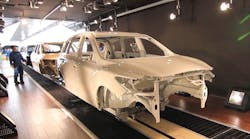In April, the U.S. Department of Energy put a spotlight on Nissan Motor Co.'s new energy-efficient paint plant in Smyrna, Tenn. Opened in January, the 250,000-square-foot facility is located adjacent to the automotive company's existing vehicle assembly plant and is described by Nissan (IW 1000/26) as its most advanced paint plant in the world.
See Also: Operations Management Strategy & Best Practices
The facility bristles with technologies designed to drive down energy use, including a new "3 wet" paint process that eliminates a high-temperature bake step; a compact spray booth design that requires less air supply and smaller exhaust systems (less electricity needed); and smaller natural gas hot water generators that service individual processes. They pull only the power needed when it is needed.
The new paint plant is Nissan North America's showcase project in the DOE's Better Buildings, Better Plants Challenge. The challenge, launched in December 2011, aims to help U.S. commercial and industrial buildings get at least 20% more efficient over the next decade.
Nissan has committed to reducing energy use in its three U.S. plants 25% by 2020.
Newly released data suggest manufacturing's energy-efficiency measures are making an impact. Total energy consumption in manufacturing declined by 17% from 2002 to 2010, according to the U.S. Energy Information Administration. Meanwhile, manufacturing gross output declined by just 3% in the same period. The significant drop in energy intensity was driven by energy-efficiency efforts as well as changes in manufacturing outputs, the statistics agency opines.
In its first month of operations, Nissan's new paint plant -- a multimillion-dolalr project -- was delivering a 30% reduction in total energy use for body-on-frame painting, according to the DOE.
Conservation Without Capital
Capital-intensive projects are not the only route to better energy management, says Jerry Thompson, senior vice president of customer solutions for Management Alternatives Ltd. His firm promotes the idea that manufacturers can find significant improvements in energy management (as well as associated cost savings) with little to no high-dollar inputs.
"Even in very good companies, they have inefficient practices," he says. Such practices can range from needlessly operating machinery, failing to optimize the equipment or performing tasks in the wrong sequence to making questionable decisions, such as using compressed air to clean the shop floor.
"You can have the best capital equipment and the best compressors in the business, but if you are misusing them in the manufacturing process, then what do you have?" he asks rhetorically.
Indeed, Mike Hugdahl, plant manager at Ingredion's Bedford Park, Ill., manufacturing facility, said leadership "was a little surprised at the amount of opportunity" Management Alternatives uncovered during an engagement there in 2009.
Energy Conversation is Routine
Since then, significant fixes have been undertaken to better manage energy usage, including introducing appropriate metrics to track energy. Moreover, energy management has become a routine part of Ingredion's conversation at Bedford Park, at both a manager and operator level, Hugdahl says.
For example, energy management is a regular topic at the plant's daily morning meeting. As well, energy management teams report to an energy task force, all engaged in improving energy management within the facility.
Perhaps most importantly, operators in this highly automated facility are making decisions around energy in the manufacturing process "minute by minute and hour by hour," says Hugdahl.
"We now have tools in place that measure energy efficiency, and they know how to respond to those numbers," he says. "They understand much better what the key drivers of energy usage are. It has now become part of normal business."
Thompson says such practices are important to sustaining an energy management initiative. He describes a behavior-based approach to energy management -- analogous to behavior-based safety but with the obvious difference being that its focus is energy.
A behavior-based approach is not about a single person "owning" energy management, he says. Instead, "energy must become everyone's business." That means aligning everyone's perception about the importance of energy management, from the leaders and managers down to the shop floor.
"It's not an easy path because you are dealing with people and human interactions and behaviors," admits Thompson. "The whole key is alignment, consistency and a feeling by management that this is important. If they don't think it is important, it won't work."



